The Prokaryotes: Domains: Bacteria Archaea - PowerPoint PPT Presentation
1 / 24
Title:
The Prokaryotes: Domains: Bacteria Archaea
Description:
Title: The Prokaryotes: Domains: Bacteria Archaea Author: Administrator Last modified by: Lisa Created Date: 4/13/2005 5:46:05 PM Document presentation format – PowerPoint PPT presentation
Number of Views:212
Avg rating:3.0/5.0
Title: The Prokaryotes: Domains: Bacteria Archaea
1
Kingdom Monera
(Or Kingdom Archeabacteria
and Kingdom Eubacteria)
2
(No Transcript)
3
Prokaryotes Review
- No true nucleus (no nuclear membrane)
- No cellular organelles
- Single celled
- The bacteria
4
Good or Bad Bacteria Activity
- Decide if the bacteria on your card is a good
bacteria or a bad bacteria - What did you use to make your decision?
- Are there any bacteria that ended up on both
sides? - Good or bad depends on you perspective! But for
humans most bad bacteria produced toxins that
negatively affect us.
5
Kingdom Monera
- All are prokaryotes
- Include bacteria and cyanobacteria (blue/green
algae)
6
Classification of bacteria
- They are classified into 2 groups
- Archaebacteria (old bacteria)
- Eubacteria (true bacteria)
7
Archaeabacteria
- Live in extreme environments
- Inhabited the Earth billions of years ago
- Eukaryotes evolved from these 1.7 billion years
ago (have the similar mRNA sequences and
polymerases)
8
There are three main groups of Archaeabacteria
- 1. extreme halophiles
- 2. methanogens
- 3. hyperthermophiles
9
1. Extreme halophiles
- can live in extremely salty environments
- some species can live in water with salt
concentrations exceeding 15. - Most are photosynthetic autotrophs.
- The photosynthesizers in this category are purple
because instead of using chlorophyll to
photosynthesize, they use a similar pigment
called bacteriorhodopsin that uses all light
except for purple light, making the cells appear
purple.
10
(No Transcript)
11
2. Methanogens
- are strict anaerobes that release methane as a
waste product of cellular metabolism. - Many live in mud at the bottom of lakes and
swamps because it lacks oxygen and some (enteric
bacteria) live in the intestinal tracts of
animals. - A large number of methanogens colonize the
intestinal tracts of ruminary grazing animals,
where they aid in the digestion of cellulose. - The methanogens living in the human digestive
tract can cause intestinal gas.
12
13
3. Hyperthermophiles
- live in extremely hot or acidic water some
species can survive temperatures over 100 degrees
Celsius. - The famous hot springs in Yellowstone are home to
this type of Archaea. - They also live around deep-sea vents.
- Most hyperthermophiles are chemoautotrophs,
meaning that they use chemicals found in the
water leaving the vents to directly produce ATP. - These hyperthermophiles often make the pools a
greenish color due to their metabolic waste. - They may also feed on dead organisms that have
sunk from higher levels of the ocean.
14
"Strain 121" has been able to double its
population during 24 hours in an autoclave at
121C (hence its name).
15
Eubacteria
- Found everywhere!
- Microscopic
- Prokaryotic
- There are more bacteria in a person's mouth than
there are people in the world.
16
Structure of bacteria
17
Structure of bacteria
- Cell wall protect and maintain osmotic balance
- Capsule found outside cell wall, added
protection, helps attach the cell - Nuclear material contains the genetic
information need for reproduction - Flagella for movement
18
Bacteria Shape
- Three main shapes
- 1. cocci spherical
- 2. bacilli rods
- 3. spirillum spiral/corkscrew
- Shapes are often used in their scientific name
19
More shapes of bacteria
- Vibrio curved
- Spirochete
- Square
- Star
20
(No Transcript)
21
Shapes can be combined with the following in
names
- Diplo two
- Strepto chain
- Staphylo cluster of cells
22
(No Transcript)
23
(No Transcript)
24
Next time
- Reproduction in bacteria
- Pathogenic bacteria































